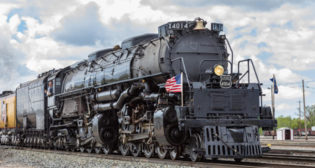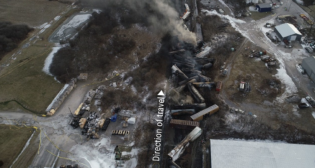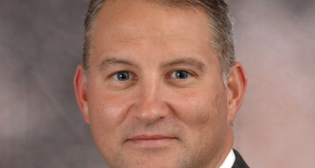
Legislative Report: Can We ‘Build Back Better’?
Written by Don Itzkoff, Contributing Editor
President Biden promised a bold rethinking of how a green approach to new infrastructure investment will put Americans to work, so perhaps infrastructure may bridge political interests otherwise far apart. And in this context, President Biden’s pick for U.S. Secretary of Transportation, Pete Buttigieg (pictured), the former mayor of South Bend, Ind., is an inspired choice. (Gage Skidmore)
RAILWAY AGE, FEBRUARY 2021 ISSUE: Railway Age provides a look at the legislative possibilities for the 117th Congress.
The insurrectionist rioters who tore through the United States Capitol wiped out most other news on Jan. 6, 2021. That day of lives lost, pain and desecration stained our nation’s history. Underneath this disgrace, Jan. 6 also confirmed the Democratic win of both special U.S. Senate runoff races in Georgia the previous day. This outcome, not conventionally anticipated right after the Nov. 3 general election, gave Democrats the slimmest of majorities in the U.S. Senate on Jan. 20 with Vice President Kamala Harris as the tie-breaker of a 50-50 chamber, adding to their control of the House of Representatives and the White House.
Democratic leadership of the Senate reorders legislative possibilities for the 117th Congress, starting with a $1.9 trillion COVID-19 relief bill President Biden sent to Congress that would allocate $20 billion for public transportation. Beyond the COVID-19 bill, transit authorities, passenger railroads and other transport modes seek billions in additional funds. Short lines intend to build on the 45G infrastructure tax credit permanency achieved last year with equitable inclusion in any new infrastructure investment measure (see American Short Line and Regional Railroad Association President Chuck Baker’s commentary). Class I railroads will advance their policy priorities, as outlined by Association of American Railroads President Ian Jefferies before Congress in late 2020: maintaining the existing balanced regulatory structure; fostering innovative technologies; and ensuring that the marketplace, not government, picks winners and losers among transportation modes.
Eno Center for Transportation expert Jeff Davis and other Beltway analysts quickly assessed new legislative prospects, such as potential use of the budget reconciliation process (which does not require the 60 Senate votes that most measures typically need to pass) to boost infrastructure funding. Yet with no votes to spare even through reconciliation, much less the 60 votes required to surmount a Senate filibuster, any major new infrastructure program—paid for or not—needs bipartisan support.
Anita Dunn, managing director at SKDK, who served as a senior adviser to the Biden campaign and has temporarily joined President Biden’s White House staff, affirmed that Democrats and Republicans must find common ground. Dunn told The Washington Post that “in a 50-50 Senate, you will not succeed without reaching out to the Republicans.” Speaking on Jan. 7 following the two Georgia Democratic wins, Dunn dismissed chatter suggesting that the Biden Administration’s path was suddenly a slam-dunk. “Yesterday our agenda was dead,” Dunn offered wryly, but “today we can pass anything we want.” As she noted, “That pendulum swings pretty wildly.”
With a Senate impeachment trial of former President Trump driving even deeper political divide, the thin Democratic majority in the House and the single-vote margin in the Senate would seem to make political agreement on virtually anything a huge lift. “Going big” on infrastructure has always been a tough sell because of cost: In 2020, Congress pushed surface transportation reauthorization off to 2021, and the Trump Administration never made “Infrastructure Week” more than a talking point. But infrastructure now may be one area where centrists can win and partisans on both sides see covered, because “fixing potholes” appeals at the local level. President Biden promised a bold rethinking of how a green approach to new infrastructure investment will put Americans to work, so perhaps infrastructure may bridge political interests otherwise far apart.

In this context, President Biden’s pick for U.S. Secretary of Transportation, Pete Buttigieg, the former mayor of South Bend, Ind., is an inspired choice. “Pete Buttigieg brings the skills and vision so needed at this difficult time for our nation,” said former Transportation Secretary Rodney Slater, now partner with Squire Patton Boggs. “The former ‘Mayor Pete’ is a quick study, sharp on his feet and a compelling persuader. Most of all, he is extraordinarily empathetic, able to take in a different viewpoint without judging. This quality—the ability to see and feel the perspective of all sides—ideally positions Pete Buttigieg as Secretary to project the clarion call that America must hear from Democrats and Republicans to come together on a renewed commitment to infrastructure investment and mobility for our future.”

At his Senate Committee on Commerce, Science, Transportation confirmation hearing Jan. 21, Buttigieg heralded a “bipartisan appetite for a generational opportunity to transform and improve America’s infrastructure.” Though some Senators questioned how new infrastructure investments would be paid for, and a spokesperson at USDOT later walked back a Buttigieg comment on openness to adjusting the federal gas tax, Buttigieg’s otherwise smooth proficiency drew raves. Senator Roger Wicker (R-Miss.), chairing the hearing in the absence of a power-sharing agreement in the 50-50 Senate, said that Buttigieg was “almost certain” to be confirmed. Noting that “your intellect has preceded you into the room,” Senator Jon Tester (D-Mont.) told Buttigieg that “you have put on a clinic” and made clear that “for all the other nominees out there, you need to look at what’s happened in the past two hours.” Tester summed up Buttigieg’s performance: “You’ve been straightforward and you know what the hell you’re talking about. That’s really pretty damn refreshing.”
Supported by President Biden’s nomination of former New York City Transportation Commissioner Polly Trottenberg for Deputy Transportation Secretary and other USDOT appointees, Buttigieg will face plenty of tough choices integral to fulfilling the Department’s core executive policy and regulatory charter. An equally vital but often overlooked aspect of the Secretary’s role is driving the public momentum and political grassroots support that translates into results on matters such as funding where Congress owns responsibility.
Dunn’s SKDK colleague Jill Zuckman, who led public affairs for USDOT in the Obama Administration under Secretary Ray LaHood, underscored the vocal power of the Transportation Secretary’s office. Zuckman said, “I expect that Pete Buttigieg will deftly use his bully pulpit to make the case for investing in transportation and infrastructure and for putting our ‘friends and neighbors back to work,’ as Secretary LaHood framed it in urging enactment of the Economic Recovery Act of 2009 amidst the Great Recession.” Zuckman further hopes that the new Secretary “will take another line from Secretary LaHood’s playbook. LaHood liked to say there are no Republican roads or Democratic bridges. In other words, we are all in this together, and partisanship has no place in this conversation.”
During last year’s presidential campaign, Buttigieg garnered attention unlike any of his USDOT predecessors, building visibility comfortably. The day in December 2020 he was nominated for Secretary, Buttigieg tweeted, “Travel in my mind is synonymous with growth, with adventure—even love. So much so that I proposed to my husband Chasten in an airport terminal. Don’t let anybody tell you that O’Hare isn’t romantic.”
O’Hare Airport replied at jet speed. “Thank you for appreciating all the connections we make possible @PeteButtigieg,” reported USA Today in capturing the airport’s tweet. “Looking forward to working with you as we continue to make our airport lovable for decades to come.” USA Today took notice, too, of the take by United Airlines, which has a big presence at O’Hare. “It was B5,” tweeted United. “Proof that love actually is all around.”
Politico has adeptly tracked Buttigieg’s social media presence and flagged that “he and husband Chasten have picked up a new board game, ‘Pan Am,’ which is incidentally not the first transportation-related game they’ve been known to play.” As Politico stated, Buttigieg is “coming into the agency with arguably more national celebrity than any Secretary before him, and he’ll be closely watched by a far larger audience than DOT usually claims.”
That is good news for rail industry and public transportation advocates seeking new approaches to leapfrog prior policy, spending and political constraints. Buttigieg is already making transportation “cool,” and he’s just getting started. If this draw trends to blue-red agreement even when other issues can’t move, then transportation and infrastructure, with rail and transit leading on greener frontiers, can be a productive and purple exemplar of “build back better.”
Donald M. Itzkoff is Chief Policy Officer for Patriot Rail Company LLC.



